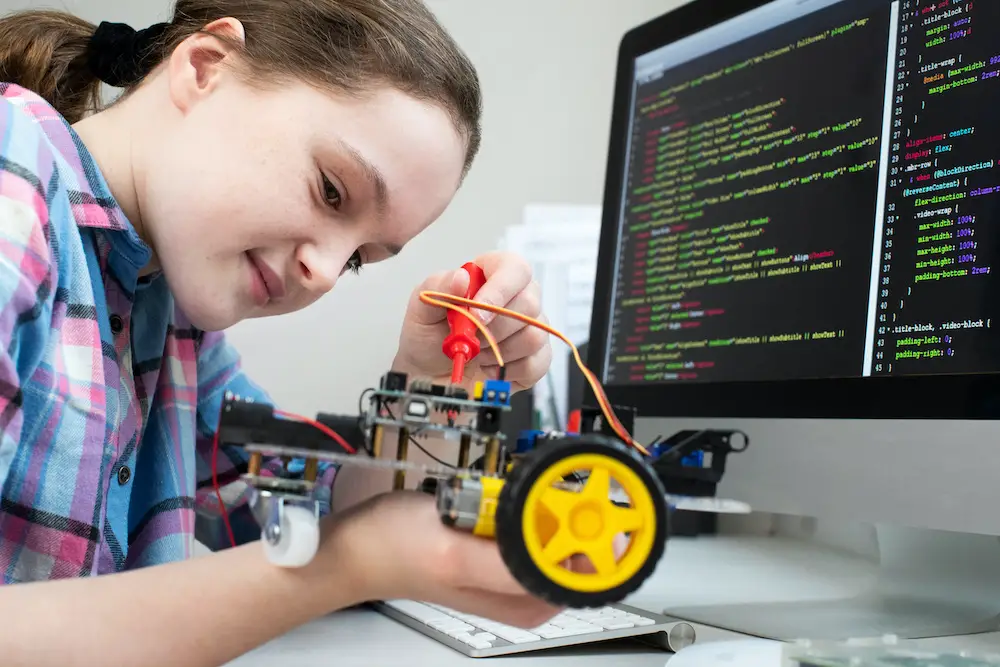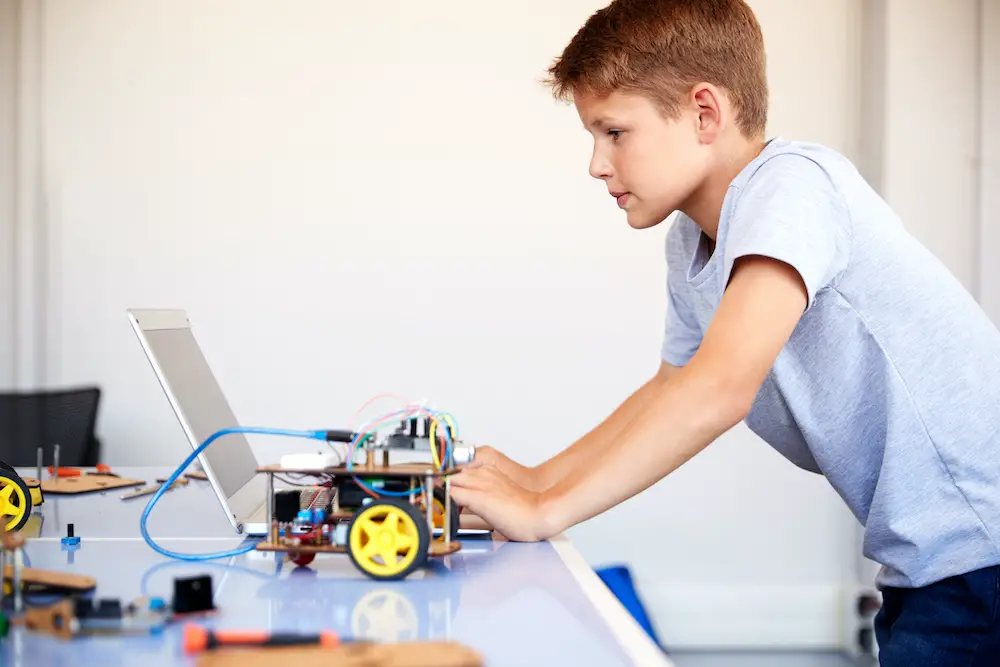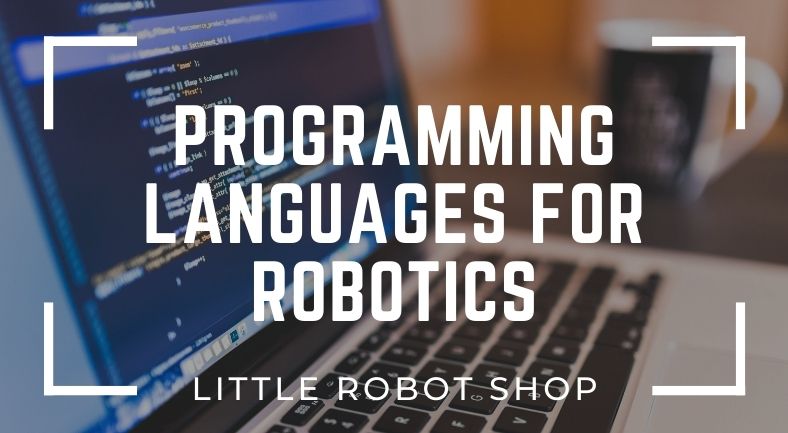As humans, we must speak in the same language to better communicate our thoughts and messages towards another person.
Since we live in a technology-driven world, we must learn to understand various programming languages and their complexities.
Most beginners start with programming languages for robotics since they are the simplest compared to computers.
Before we proceed to robot programming languages, let us first understand why it is essential in our daily lives.
You may also like: Best Programmable Robotic Arm Kits For Beginners
What Is Robotics?
It’s a combination of several fields of studies related to engineering and computer science.
It includes the construction, design, use, and operation of robots.
Its main goal is to create smart machines for the benefit of humans.
Why Is Robotics Programming Important?
The younger generation needs to learn programming language for robotics to enhance their creativity and innovative thinking.
Knowing the basics of robotics will prepare them for future challenges while improving their abilities to become productive individuals.
One great way to introduce programming to these students is through physical robots.
It gives them concrete proof of their success or failure.
Robotics programming helps kids better understand that science, technology, engineering, and math must interact and work together.
As they improve their creative skills, they also learn to make actual products that work according to how they programmed it to function.
Programming language for robotics and building the actual product are complex processes that may frustrate some students.
As these students struggle with different ideas, they will also learn to persevere and conquer challenges to succeed.

Does Robotics Need Coding?
In brief, we have discussed how vital programming or coding is in our technology-driven environment, which answers whether robotics needs coding.
Coding and robotics go hand in hand. It’s a significant skill that students need to learn and develop if they want to succeed in the future.
Robots only function based on the programs created for a specific task.
Codes or programs are instructions fed into the system to produce an outcome.
Most programmers use coding languages in the ordinary everyday text, so it’s not difficult to understand.
Once all the programs are complete, they will be collected and edited into machine codes using different programming languages.
Which Programming Language Is Used in Robotics?
There is no single and specific answer to this question, but we can provide the most popular languages used by creators, developers, and robotics specialists.
Here are ten of the most popular programming languages in robotics today.
- C and C++
- Python
- Java
- C# and .NET
- MATLAB
- Hardware Description Languages or HDLs
- LISP and Prolog
- Industrial Robot Languages
- Scratch
- Pascal
1. C and C++
We chose these two programming languages for robotics as the first on our list since most robot creators consider them their standard language.
A lot of robotics hardware libraries use either of these two languages. The C language is one of the most effective when it comes to coding.
However, most programmers opt to use C++ because they consider it the updated version of the language.
These matured programs can interact with low-level hardware allowing real-time action.
Learning this language and creating proper and efficient codes may take time compared to other languages.
2. Python
Python is one of the most popular programming languages today partly because it’s one of the main coding styles used in most Robot Operating Systems.
It’s not difficult to learn and read, making it easy to write applicable codes with an option to using it again.
3. Java
Java is familiar with programmers coming from a computer science background.
This programming method does not require a machine code compilation.
The Java virtual machine automatically interprets the commands during runtime.
This process allows you to use the same program on other devices.
4. C# and .NET
Microsoft created the C# language in the early parts of 2000.
It’s easier to learn than the previous C programming languages; hence, its popularity.
It’s easy to link and merge with other projects due to its wide array of available libraries.
It also operates on the .NET foundation of Microsoft.
The major downside of this coding language is its software development limitation to Windows.
Some programmers are having a hard time using this language on non-Windows computers.
5. MATLAB
MATLAB, which means Matrix Laboratory, is considered a complete programming environment and not just a language.
It works best in matrix mathematics, which is an essential part of the robotics world.
Most engineers use it to analyze and imitate the robots.
It’s a powerful system for data analysis, allowing you to write useful programs.
It has a popular robotics toolbox that permits complex reproduction.
Some robot programmers, though, claim that this system is not designed for robot hardware.
6. Hardware Description Languages or HDLs
Electronic engineers are more familiar with this coding language.
That’s because they use it to create low-level electronics and digital logic circuits for robots.
It describes a circuit with words and symbols converted to configuration data by software.
It is then transferred to digital subcircuits for the program to function.

7. LISP and Prolog
These two programming languages are Artificial Intelligence coding methods.
Lisp is considered the second-oldest coding language, which is partly used in ROS or Robot Operating System.
Prolog, on the other hand, is known as the logic programming language.
Programmers use it to describe knowledge through a code that is understood by the AI’s design.
8. Industrial Robot Languages
Most robot manufacturers created a robot programming language exclusive to their brand.
Some languages are based on Pascal but are still incorporated with the brand’s robot language.
9. Scratch
Scratch is a new coding method explicitly designed for beginners.
It’s a visual programming language targeting users from eight to 16 years old.
This programming language is common in robotic clubs and technology classes in most schools.
It uses the drag and drop system of connecting different blocks to create a program.
It’s a great way of introducing robotics and coding to young children and new programmers.
10. Pascal
As we mentioned above, some industrial robot programming languages are based on Pascal.
This introductory programming language is created to boost excellent coding practices.
Robot Programming Languages
We discussed some of the most used programming languages for robotics today. But which one should you learn first?
You can learn one or all available programming languages around, but you can start from what suits your purpose or the project you are working on.
If you are looking for something to practice your programming skills, you can choose from among the robot kits for beginners in the market.

Matt is the founder of the Little Robot Shop, who has spent much of the last decade hacking home cleaning with various robots and devices to make keeping his home clean as easy as possible. Not an easy task with two young children.
When not working on the Little Robot Shop website or YouTube channel, he works as technical support and product specialist for a fast-growing digital company. He does his best to get his younglings to code, which will be an essential skill in the future.
